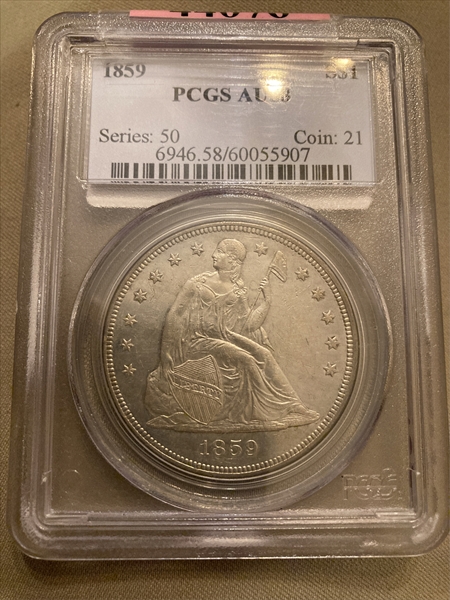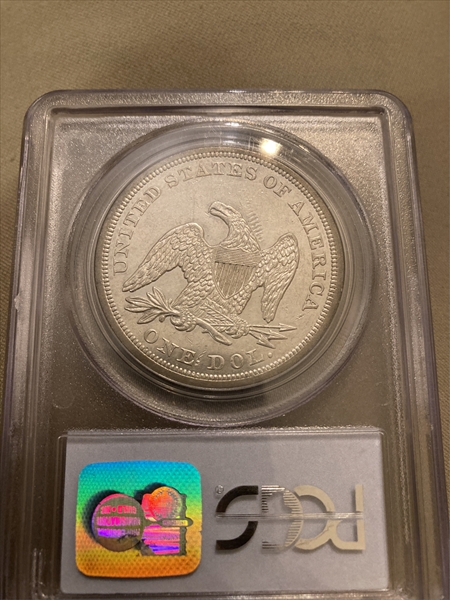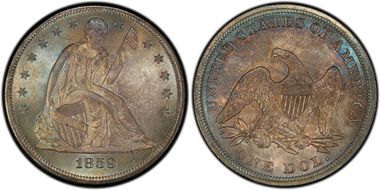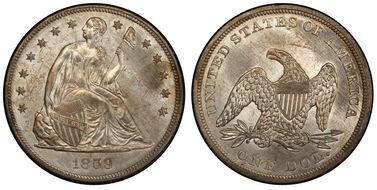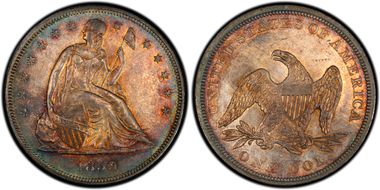1859 $1 AU58 认证号60055907, PCGS号6946
拥有者评论
OC-4 R4
专家评论
Q. David Bowers
The following narrative, with minor editing, is from my "Silver Dollars & Trade Dollars of the United States: A Complete Encyclopedia" (Wolfeboro, NH: Bowers and Merena Galleries, Inc., 1993).Coinage Context
Still another export issue: John M. Willem, in The United States Trade Dollar (p, 46), noted that the silver dollar coinages of 1859 and 1860, from all three mints, were made primarily for export to China. Most of these went to northern ports in China where the pieces were melted down and converted to bullion.
The Comstock Lode: New supplies of domestically mined silver remained scarce in the United States. However, this would change in the years to come, for in 1859 two prospectors, Patrick McLaughlin and Peter O'Reilly, discovered a deposit of ore on Mt. Davidson, in Washoe, Nevada, on property to which Henry Tompkins Paige Comstock, age 39, claimed rights. Comstock sold his interest, but his name remained behind in the Comstock Lode. The ore proved to yield metal in the ratio of about 75% silver and 25% gold and assayed about $4,700 per ton (as in typical ores, only a fraction of the ore consisted of valuable metal, but in this case the fraction was unusually valuable).
Although estimates have varied widely over the years, one modern source states that the Comstock during the next 11 years and $397 million by 1882. (Trager, The People's Chronology, p. 497.)
Silver from Arizona: New discoveries of silver in Arizona were exploited in 1859, and shipments of the metal began to reach the East, mostly by way of EI Paso, Texas. As of October 6, 1859 there were nearly two tons of silver bullion awaiting shipment from that point. Transportation was by mail coach, and was of uncertain safety. (Cf. The Bankers' Magazine, November 1859, pp. 404-405.)
Numismatic Information
Circulated grades: As noted, the vast majority of the mintage of over a quarter million 1859 Liberty Seated dollars went to the Orient, where they were soon melted. Examples of this high-mintage date are scarce today in all grades.
Mint State grades: Very few Uncirculated specimens exist. Dealers' memories are not always precise on this, for the availability in quantity of Mint State 1859-O sometimes causes confusion, but mint markless coins are rarities. In 1992, dealer specialist Chris Napolitano told me that he had never had a Mint State 1859 in stock, in the course of handling several collections and many rarities. (Conversation at the Central States Numismatic Society Convention, Minneapolis, April 30, 1992.) In this grade the 1859 may be influenced by the resubmission of the same coins.
Varieties
Business strikes:
1. Normal Date: Breen-5457. Three obverse and five reverse dies were made for this date, but it is believed that not all were employed.
Dies prepared: Obverse: 3; Reverse: 5
Business strike mintage: 256,500; Delivery figures by day: April 18: 33,000; April 19: 22,000; April 28: 2,500; June 27: 16,000; July 8: 13,000; July 21: 20,000; October 6: 22,000; October 13: 18,000; October 18: 17,000; October 24: 24,000; October 25: 16,000; November 21: 29,000; November 23: 22,000; December 10: 2,000.
Estimated quantity melted: Unknown
Characteristics of striking: Many examples are weakly struck at one or both of these areas: stars (irregular weak striking, with stars 1 and 4 sharp and the others, especially 8 and 9, weak); head of Miss Liberty.
Known hoards of Mint State coins: None
Commentary
Most business strike 1859 silver dollars were exported to China.
Additional Information
The Dollar Coinage from 1859 Onward
The following is from R.W.Julian:(Specific contribution to this book, February 1992. R.W. Julian places less emphasis on the exportation of dollars during this period than did John M. Willem (in The United States Trade Dollar) or the present author (QDB). Source material is often conflicting.)
The heavy coinage of 1859-1860 arose from three reasons.
First of all, the Treasury had shut off Snowden's illegal high price purchases in 1858. Second, there was a heavy imbalance in the silver imports and exports in favor of the United States in 1858-59. The third reason was the sudden and heavy mining of silver beginning in 1859 at a time when the nation had no use for increased quantities of this metal; the economy was just coming out of a recession and the mints were buying very little, even at reduced rates, for subsidiary silver coinage. I do not think that the Oriental trade had any bearing on this problem, although clearly a few people in 1859 and 1860 thought that it did.
There is no doubt in my mind that silver dollars did indeed go to the Orient, but purely as bullion and only in very small quantities. If there had been a real demand for the American silver dollar, then there would have been no need for the Spanish or Mexican coin to be sent to the Far East. The minuscule coinage at San Francisco in 1859 (when there were ample supplies of silver to be had, either from the Comstock or as a by-product of gold mining in California) is a telling point against silver dollars being sent in quantity to the Orient. If American dollars could have been used, even as bullion, the premium on the Mexican would have dropped to bullion value. There is some doubt that those dollars that did stray to the Orient went to China; Pollock, on more than one occasion, referred to them being used in the East India trade, which seems to imply Indo-China or the Dutch East Indies rather than Canton.
There was very heavy melting of dollars in 1861 for use as bullion in the manufacture of subsidiary silver. In one case there were 40,000 silver dollars melted at Philadelphia. I suspect that a careful investigation of archival material would turn up meltings well in excess of that. (This may have been a contributory factor to the rarity of business strike silver dollars of the 1853-1859 span)
There is also the question of ingots. San Francisco and Philadelphia both made large quantities of silver ingots of varying quality, according to the needs of the depositor. (At times, in the early 1870s for example, Carson City made more in bars than it made in coins.) Ingots would have been much easier to send to the Orient and they were readily available. The whole point of the later trade dollar coinage was to introduce a coin to the Far East, which was considered a better way to dispose of our silver than mere ingots.
The following is from Harry Salyards:
Concerning the possibility of heavy import surcharges with silver as a cause of the large coinages of silver dollars of 1859-60, to me this is not convincing when one considers that there was a constant import surplus during 1854-57 of almost as great a magnitude, with no corresponding effect on dollar coinage; and there was actually an export surplus on silver in 1860, for the first time since 1853 (Hepburn, table p. 70, op cit.). Plus, as commented upon previously, while the Comstock discovery dates to 1859, the boom years in silver production came a good deal later. (Specific contribution to this book, November 1992.)
Collecting Silver Dollars in 1859
In 1859 in the American Numismatical Manual; Montroville Wilson Dickeson, M.D., commented on the availability of silver dollars, including the Liberty Seated series. His remarks cover much of the first two decades of the issue and give an interesting view of how such coins were considered by numismatists of the era.
The 1840 dollar, the first year of issue of the Liberty Seated series, was called "scarce," while the issue of the following year, 1841, was designated as "plenty." Similarly, 1842 and 1843 were "plenty," but 1844 was "rare" and 1845 "scarce." Dollars of 1846 were likewise "scarce," but those of 1847 were "plenty." Followed by the "scarce" 1848 and "plenty" of the 1849 issue, the 1850 dollar was considered to be "scarce," and the 1851 dollar "extremely rare." The dollar of 1852 was considered "rare," while that of 1853 was "scarce" The 1854 Liberty Seated dollar, just five years old when Dickeson wrote his book in 1859, was already considered to be "rare," but 1855 for some reason was in the "plenty" category, followed by 1856 "rare" and 1857, the last year studied, "plenty." Doubtless, Dickeson knew little about the 1857 dollar except that it was a current issue. Indeed, his information apparently was compiled in the summer of 1857, for his comments referred to production half way through the year.
PCGS #
6946
设计师
Christian Gobrecht
边缘
Reeded
直径
38.10 毫米
重量
26.73 克
铸币数量
255700
金属成分
90% Silver, 10% Copper
更高评级数量
38
评级较低的钱币数量
134
地区
The United States of America
价格指南
PCGS 数量报告
拍卖 - PCGS 评级的
拍卖 - NGC 评级的
稀有性和存量估计 了解更多
| 所有评级 | 1100 |
| 60或以上 | 60 |
| 65或以上 | 2 |
| 所有评级 | R-4.9 |
| 60或以上 | R-8.4 |
| 65或以上 | R-9.9 |
| 所有评级 | 5 / 30 TIE |
| 60或以上 | 13 / 30 TIE |
| 65或以上 | 7 / 30 TIE |
| 所有评级 | 12 / 45 TIE |
| 60或以上 | 20 / 45 TIE |
| 65或以上 | 8 / 45 TIE |




















